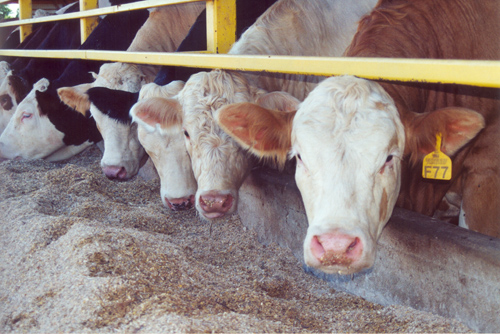
Beef Buzz News
USDA's Latest Cattle on Feed Report Reveals Implications of Heavyweight Feedlot Placements
Mon, 27 Feb 2017 12:26:48 CST
 The US Department of Agriculture released the most recent Cattle on Feed report, last Friday afternoon. Radio Oklahoma Ag Network Farm Director Ron Hays reached out to Dr. Derrell Peel, Oklahoma State University Extension Livestock Market Economist, for his analysis of the report. You can listen to him break down the numbers with Hays, by clicking or tapping the LISTEN Bar below. Peel also summarized his analysis in his article for this week's Cow/Calf Corner Newsletter.
The US Department of Agriculture released the most recent Cattle on Feed report, last Friday afternoon. Radio Oklahoma Ag Network Farm Director Ron Hays reached out to Dr. Derrell Peel, Oklahoma State University Extension Livestock Market Economist, for his analysis of the report. You can listen to him break down the numbers with Hays, by clicking or tapping the LISTEN Bar below. Peel also summarized his analysis in his article for this week's Cow/Calf Corner Newsletter.
"The February USDA Cattle on Feed showed that January feedlot placements were 111.3 percent of last year while marketings were 110.2 percent of one year ago. There was one extra business day this January compared to last year. The February 1 on-feed total was 10.8 million head, 100.7 percent of last year. The report was well anticipated with no surprises in any of the numbers.
"Something new beginning with this report is more detail on heavyweight feedlot placements. This and future reports will include a breakdown of over 800 pound placements into 8-900 pounds, 9-1000 pounds and over 1000 pounds for the national totals. For individually reported states, the reports will detail 8-900 pounds and over 900 pound totals. This additional weight breakdown is important and needed as heavy feedlot placements have increased significantly in recent years. Prior to 2012, the annual average percent of heavy placements each month was fairly constant at about 28 percent. Starting in 2012 the percent of heavy placements has increased steadily to the 2016 average of 36.8 percent. Not knowing how weights were distributed above 800 pounds has made it difficult to anticipate the market timing of heavy placements. The new data shows that 8-900 pound placements made up 71.8 percent of over 800 pound placements in January compared to 74.1 percent one year ago. 9-1000 pound placements made up 20.3 percent of over 800 pound placements compared to 19 percent in January, 2016. Placements over 1000 pounds were 7.9 percent of heavy placements compared to 6.9 percent last year. In total, placements over 900 pounds represented 8.1 percent of placements in January compared to 8.4 percent last year. Over time the value of this data will grow as more history is accumulated and averages and seasonal patterns emerge.
"Additional heavy-weight feedlot placements are one of several factors that have contributed to rapid increases in slaughter and carcass weights in recent years. Data on over 500 thousand head of cattle from a large, Southern Plains feedlot shows that heavy placements have different implications for final feedlot weight of cattle compared to lighter-weight placements. The feedlot data shows that for steers placed between 600-850 pounds, each additional pound of placement weight increases sale weight by an average of 0.52 pounds. However, above 850 pounds, each additional pound of placement weight is matched by one additional pound of sale weight. A similar but even more exaggerated pattern is true for heifers, with placements between 550-800 pounds producing an average of 0.48 pounds of sale weight for each additional pound of placement weight. For heifers placed over 800 pounds, each additional pound of placement weight results in 1.38 pounds of additional sale weight.
"The increase in heavy-weight feedlot placements in recent years was no doubt heavily motivated by high feedlot cost of gain over much of the period. However, even with sharply lower feed costs in 2017, there are several reasons that placement weights may not decline much in the coming months. Feedlots generally prefer to feed older, heavier cattle which is more possible with growing cattle numbers. Continued changes in cattle genetics, feeding management and feeding technology allow cattle to be fed efficiently to heavier weights. Placement of heavier animals in feedlots may also be contributing to the increase in the Choice grading percent in recent years. Nevertheless, slaughter and carcass weights will likely increase more slowly or plateau in coming years, in part because of demand limitations for ever larger carcasses."
Listen to Dr. Peel breakdown the numbers in the latest Cattle on Feed report with Ron Hays, on today's Beef Buzz.
The Beef Buzz is a regular feature heard on radio stations around the region on the Radio Oklahoma Network and is a regular audio feature found on this website as well. Click on the LISTEN BAR below for today's show and check out our archives for older Beef Buzz shows covering the gamut of the beef cattle industry today.
WebReadyTM Powered by WireReady® NSI
Beef News






